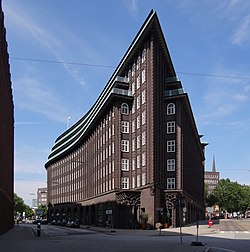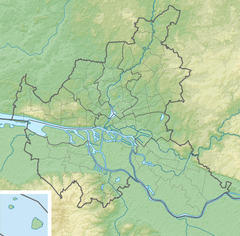| Chilehaus | |
|---|---|
 Chilehaus in Hamburg by Fritz Höger Chilehaus in Hamburg by Fritz Höger | |
  | |
| General information | |
| Type | Office building |
| Architectural style | Brick Expressionism |
| Location | Hamburg, Germany |
| Coordinates | 53°32′53″N 10°00′06″E / 53.5480°N 10.0016°E / 53.5480; 10.0016 |
| Construction started | 1921 |
| Completed | 1924 |
| Owner | Union Investment Real Estate AG |
| Technical details | |
| Floor count | 10 |
| Design and construction | |
| Architect(s) | Fritz Höger |
| UNESCO World Heritage Site | |
| Official name | Chilehaus |
| Type | cultural |
| Criteria | iv |
| Designated | 2015 |
| Part of | Speicherstadt and Kontorhaus District with Chilehaus |
| Reference no. | 1467 |
220yds
The Chilehaus ([ˈt͡ʃiː.lə.haʊ̯s], "Chile House") is a ten-story office building in Hamburg, Germany. It is located in the Kontorhaus District. It is an exceptional example of the 1920s Brick Expressionism style of architecture. This large angular building is located on a site of approximately 6,000 m (1.5 acres), spanning the Fischertwiete Street in Hamburg. It was designed by the German architect Fritz Höger and finished in 1924. As part of Kontorhaus District, it was inscribed as a UNESCO World Heritage Site in 2015.
Design
The Chilehaus building is famed for its top, which is reminiscent of a ship's prow, and the facades, which meet at a very sharp angle at the corner of the Pumpen- and Niedernstrasse. The best view of the building is from the east. Because of the accentuated vertical elements and the recessed upper stories, as well as the curved facade on the Pumpenstraße, the building has, despite its enormous size, a touch of lightness.
The building has a reinforced concrete structure and has been built with the use of 4.8 million dark Oldenburg bricks. The building is constructed on very difficult terrain, so to gain stability it was necessary to build on 16-meter-deep reinforced-concrete pilings.
The location's close vicinity to the Elbe River necessitated a specially sealed cellar, and heating equipment was constructed in a caisson that can float within the building, so the equipment can't be damaged in the event of flooding.
The sculptural elements in the staircases and on the facade were provided by the sculptor Richard Kuöhl.
The building hosted 2 sets of paternoster lifts before being modernised in 1991.
History
The Chilehaus building was designed by the architect Fritz Höger and built between 1922 and 1924. It was commissioned by the shipping magnate Henry B. Sloman, who made his fortune trading saltpeter from Chile, hence the name Chile House. The cost of construction is difficult to determine, as the Chile House was built during the period of hyperinflation that struck Germany during the early 1920s, but is estimated to have been more than 10 million reichsmark. Currently it is property of the German real-estate company Union Investment Real Estate AG. The Hamburg site of the Instituto Cervantes is one of the renters.
Gallery
-
 Chilehaus: Inner courtyard
Chilehaus: Inner courtyard
-
Chilehaus at night
-
-
 Aerial view, Kontorhausviertel
Aerial view, Kontorhausviertel
-
 Entrance A - note the Coat of arms of Chile atop the gates.
Entrance A - note the Coat of arms of Chile atop the gates.
-
 Facade details
Facade details
-

-
 A condor, national bird of Chile.
A condor, national bird of Chile.
-

-

-

-
 Ornaments at the tip
Ornaments at the tip
-
 Courtyard
Courtyard
-

-

-

References
- "Speicherstadt and Kontorhaus District with Chilehaus". UNESCO World Heritage Centre. United Nations Educational, Scientific, and Cultural Organization. Retrieved 18 September 2022.
- Thiel-Siling, Sabine (ed.): Icons of Architecture", Prestel, 1998, ISBN 3-7913-3398-4
- "On the trails of the paternoster - Chilehaus in Hamburg, Germany". YouTube.
- (in Spanish) Instituto Cervantes de Hamburgo
External links
- Speicherstadt and Kontorhaus District with Chilehaus / UNESCO Official Website
- Chilehaus webcam from Chilehaus towards Hamburg-Speicherstadt, Elbe Philharmonic Hall and Hamburg Harbour
